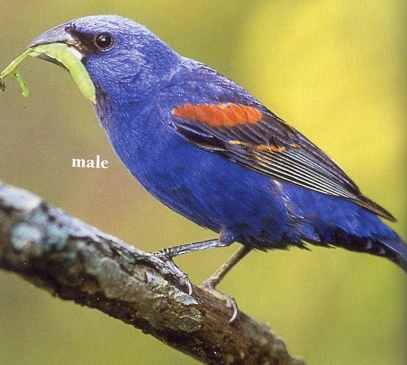|
Large
finch, bright purple-blue body, black face, and two wide, brown wingbars.
Dark wings, tail. Hops on ground to forage. Gleans from bushes, weeds
and trees. Feeds on insects, snails, grains, seeds and fruits. Swift
flight, alternates rapid wing beats with wings pulled to sides.

|
BLUE
GROSBEAK
Guiraca caerulea
PASSERIFORMES
Cardinals and Grosbeaks (Cardinalidae)
Range
and Habitat
Breeds from California, Colorado, Missouri, Illinois, and New Jersey
southward and spends winters in the tropics. Preferred habitats include
brushy, moist pastures, and roadside thickets.
SOUND:
"pink"
The Blue Grosbeak was first described in 1758 by Carolus Linnaeus, Swedish
botanist, physician and zoologist.
It was formerly placed in its own genus, Guiraca. Similarities with
buntings in genetics, behavior, molts, and plumages led to its inclusion
in the bunting genus Passerina.
It sometimes uses snakeskin as nesting material,
which is thought to thwart predators.
A group of grosbeaks are collectively known as a
"gross" of grosbeaks.
The Blue Grosbeak has a very large range, extending to around 5,300,000
kilometers and can be found in subtropical and tropical forest or shrubland
ecological systems. It is primarily found in North, Central, and South
America, but has been seen in places such as Barbados and the Cayman
Islands. The global population is believed to be about 7,700,000 birds.

|




